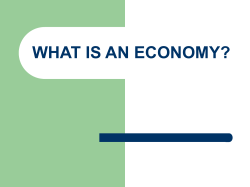
The paradox of soil
Landshackled economies The paradox of soil Land, the centre of the preindustrial economy, has returned as a constraint on growth Apr 4th 2015 | From the print edition THE history of economics has been, among other things, a story of learning to care less about land. The physiocrats of 18thcentury France saw it as the primary guarantor of wealth. Adam Smith included it alongside labour and capital as one of the three factors of production that combined to generate output. A little later Thomas Malthus saw its innate scarcity as ensuring eventual catastrophe in the face of exponential population growth. Instead of succumbing to catastrophe Western countries found ways to work around land’s scarcity, some of them ingenious—skyscrapers, artificial fertiliser, railways, suburbs—and some nefarious—dispossessing the oppressed and colonised. Improved transport allowed land farther off to do the work that land close at hand had done before, whether by producing crops half way round the world or housing workers out in the suburbs. High productivity allowed more food to be grown on fewer farms. The value of land relative to GDP fell remorselessly (see chart 1). By the second half of the 20th century land was sufficiently marginalised in richworld economies that it scarcely registered in economics textbooks. By the 1970s some seers, noting the falling cost and increasing power of information technology, convinced themselves that the textbooks were anticipating the way of the world: land and location would soon cease to matter in real life, too. Instead, concern over land has come roaring back. The issue is not overall scarcity, but scarcity in specific places—the cities responsible for a disproportionate amount of the world’s output. The high price of land in these places is in part an unavoidable concomitant of success. But it is also the product of distortions that cost the world dear. One estimate suggests that since the 1960s such distortions have reduced America’s GDP by more than 13%. Old Kent Road to Mayfair Land’s new relevance is rooted in two main developments. The first, ironically enough, is related to the revolution in computers and communications that was beginning to become evident in the 1970s. In some ways this revolution has brought about the “death of distance” foreseen by Frances Cairncross (a former journalist at The Economist). Supply chains leap borders and oceans; calls to customer services can be answered a continent away. But if distance has died, location has not. In the middle of the 20th century many big, previously vibrant cities in the rich world were shrinking. In the 1980s, in some of them, that turned around. Edward Glaeser of Harvard University and Giacomo Ponzetto of CREI, a research centre in Barcelona, reckon that this was because information technology made work in some knowledgeintensive industries far more lucrative. Financial traders could manage more money across more investors; software firms could sell their products cheaply and easily across a global market. As the return to knowledgeintensive activities exploded, so did the economic fortunes of ideaproducing places. There is support for this idea in research done by Thor Berger, of Lund University, and Carl Benedikt Frey, of the University of Oxford. Before the 1980s there was no statistical link between the skilllevel of a city’s workforce and its tendency to create new kinds of work. From the 1980s on, by contrast, new job categories appeared with much greater regularity in places with highly skilled workers than in those that lacked them. What is more, Mr Glaeser and his colleague Matthew Resseger find a close relationship between the population of a metropolitan area and the productivity of workers within that area. It seems that workers accumulate knowledge faster in cities with lots of idea industries. Top cities became hotbeds of innovative activity against which other places could not easily compete. The people clustered together boosted each others’ employment opportunities and potential income. From Bangalore to Austin, Milan to Paris, land became a scarce and precious resource as a result; the economic potential of a hectare of a rural Kentucky county is dramatically lower than that of a hectare in Silicon Valley’s Santa Clara county. And there is only so much of Santa Clara to go around. Yet more Santa Clara could be built, were it not for the second and more distressing factor behind land’s return: the growing constraint imposed by landuse regulation. The Santa Clara town of Mountain View, for instance, is home to some of the world’s leading technology firms. Yet nearly half of the city’s homes are singlefamily buildings; the population density is just over 2,300 per square kilometre, three times lower than in none toodensely populated San Francisco. The spread of landuse regulation is not hard to understand. The clustering that adds to local economic vibrancy has costs, too, as the unregulated urban booms of the 19th century made clear. Crowded slums were fertile soil for crime and epidemics; filthy air and water afflicted rich and poor alike. Officials began imposing new rules on those building in cities and, later, on those extending them: limiting heights and building designs; imposing maximum densities and minimum parking requirements; setting aside “green belts” on which development was prohibited. Such regulations have steadily expanded in scope and spread to cities around the world. As metropolitan economies recovered from their mid20thcentury slump populations began growing again. The numbers of people living in the central parts of London and New York have never been higher. And as demand for quality housing increased the unintended consequences of the thicket of building regulation that had grown up in most cities became apparent. David Ricardo, an eminent early19thcentury economist who was, among other things, a friend of Malthus’s, would have recognised the issue. Back when land was at the centre of the discipline his observations led him to the idea of a rent: an unearned windfall accruing to the owner of a scarce resource. Strained food supply would raise food prices, he reasoned, which would encourage landowners to bring ever more land under cultivation. But higher food prices benefited all landowners. A lord sitting on highly productive agricultural land suddenly found his profits swelling: not as a result of innovation on his part but because humanity needed more of something he happened to own. This is what is happening in the world’s cities today. According to data gathered by Robert Shiller, of Yale University, the inflationadjusted cost of building new housing in America is roughly the same now as it was in the 1980s. The inflationadjusted cost of buying a new home, by contrast, has risen by 30% over the same period (during the property bubble of the 2000s house prices climbed a great deal further before falling back). Individual cities have experienced even larger increases. From 1993 to 2013 prices in Boston and San Francisco rose by 60% in real terms. American cities are not exceptional. Economic change led to the rejuvenation of cities around the world, stress on stagnant housing stocks, and soaring housing costs. In many developed economies, the value of housing is an ever greater store of wealth (see chart 2) Belleville to Rue de la Paix Economists studying the issue generally reckon that rising housing costs are a product of the rising cost of land. David Albouy of the University of Illinois and Gabriel Ehrlich of America’s Congressional Budget Office reckon that in America land accounts for a third of total housing costs, and close to half in some metropolitan areas. A high share of land in housing costs results in the creation of large rents for landowners. If regulatory limits on building heights and density were relaxed, fewer plots of land would be needed to satisfy a given level of demand. That would reduce the rents collected by landowners, since any uptick in demand could quickly be met by new development. Just as soaring agricultural productivity led to a decline in the relative economic power of rural landowners in the 19th and 20th centuries, the relaxation of strict limits on development would lead to a decline in property wealth relative to the economy as a whole. More of the gains of economic activity would flow to workers and investors. Instead building regulations keep urbanland productivity low, and the costs are staggering. A 2005 study by Mr Glaeser and Raven Saks, of America’s Federal Reserve, and Joseph Gyourko, of the University of Pennsylvania, attempted to derive the share of property costs attributable to regulatory limits on supply. In 1998 this “shadow tax”, as they call it, was about 20% in Washington, DC, and Boston and about 50% in San Francisco and Manhattan. Matters have almost certainly got worse since then. Similar work by Paul Cheshire and Christian Hilber, of the London School of Economics, estimated that in the early 2000s this regulatory shadow tax was roughly 300% in Milan and Paris, 450% in the City of London, and 800% in its West End. The lion’s share of the value of commercial real estate in Europe’s most economically important cities is thus attributable to rules that make building difficult. One may find it hard to sympathise with Mayfair hedge funds facing high rents. But the net effect of these costs is felt more by the poor than by the rich. Take American homeowners. The fact that 60% of households own property might seem to suggest that rising house prices and inflated land values were good for a large swathe of the middle class. Yet Edward Wolff of New York University notes that the middle class enjoyed much less of a boost to wealth because of an accompanying rise in mortgage debt (see chart 3). Meanwhile poorer Americans, who rent their homes, experienced soaring housing prices as a large and sustained increase in their cost of living. Housing wealth has played a critical role in rising inequality, to which Thomas Piketty, an economist at the Paris School of Economics, drew attention in his bestselling book “Capital in the TwentyFirst Century”. In a recent paper Matthew Rognlie, a doctoral student at MIT, noted that the rising share of national income flowing to owners of capital, rather than workers, is largely attributable to increased payments to owners of housing. Capital income from housing accounted for just 3% of the total in 1950 but is responsible for about 10% today. Land rents are also captured by landowners in many emerging markets. According to CBRE, a property company, Beijing and New Delhi are among the world’s ten most expensive office markets, while Kuala Lumpur and Jakarta are among those with the fastest price increases. Extremely fast growing areas are often crucial to developing economies, which means poorly regulated property markets can do a lot of harm. In India’s big cities onerous permitting procedures, tight rent control, and strict limits on how land may be used have heavily distorted patterns of growth and the allocation of its benefits. Growth in the rents available to property owners fuels corruption and wastes resources. Landowners work to strengthen development restrictions while politicians cash in on their ability, through selective development approval, to grant fortunate supplicants a windfall. In economies where political corruption is already a problem the renaissance of land may be especially corrosive. In October 2014 the Times of India reported that the bribes required to clear the various stages of the planningpermission process in central Mumbai could add up to as much as half of basic building costs. Residential property value per square mile $m, 2009-13 Price per square mile National 0.72 0 to 0.39 Total value Average price Value per person State Housing density Population density County 4.6 New York (7) 0.4 to 0.99 Owner occupancy 1 to 1.99 Source: Census Bureau; The Economist 16,548 New York (1) 2 to 3.99 4 to 14.99 15 to 249.9 Over 250 Double-click/tap any county to zoom The ugliest effect of the return of land, though, may be the brake it applies to the economy as a whole. One of the main ways economies increase worker productivity, and thus grow richer, is through the reallocation of people and resources away from lowproductivity segments to more efficient ones. In business this means that bad firms go bust and good ones grow to great size. Something similar should hold for cities. Where workers can be put to use at high levels of productivity labour scarcity will lead to fast growing pay packets. Those pay packets will attract workers from other cities. When they migrate and find new, highpaying work, the whole economy benefits. Mediterranean Avenue to Boardwalk But that process is now breaking down in many economies. For workers to move to the high wages on offer in San Francisco, they must win an auction for a home that provides access to the local labour market. The bidding in that auction pushes up housing costs until there are just enough workers interested in moving in to fill the available housing space. Salaries that should be sending comehither signals are ending up with rentiers instead, and the unfairness can trigger protest, as it has in San Francisco. Many workers will take lower paying jobs elsewhere because the income left over after paying for cheaper housing is more attractive. Labour ends up allocating itself toward lowproductivity markets, and the whole economy suffers. ChangTai Hsieh, of the University of Chicago Booth School of Business, and Enrico Moretti, of the University of California, Berkeley, have made a tentative stab at calculating the size of such effects. But for the tight limits on construction in California’s Bay Area, they reckon, employment there would be about five times larger than it is. In work that has yet to be published they tot up similar distortions across the whole economy from 1964 on and find that American GDP in 2009 was as much as 13.5% lower than it otherwise could have been. At current levels of output that is a cost of more than $2 trillion a year, or nearly $10,000 per person. The good news is that the world’s urbanland scarcity is largely an artificial problem. The bad news is that that does not make it a soluble one. Redressing strict land regulation is among the most politically fraught of policy issues. It is in many ways like other toxic issues, such as trade or immigration. The society on the receiving end of new imports or population inflows benefits as a whole, but those put out of business by competition or dismayed by cultural change feel a disproportionate level of damage, and organise in opposition. And in the case of land values this opposition will be rich. There are ways to address this with policy. Governments could aim specific assistance at those harmed by dense development, as they have to those affected by liberalised trade. Disbursing some of the tax revenue earned as a result of new development to landowners within a small area around that development to compensate for shortterm hardship would reduce opposition to new building. Or they could heed the advice of Henry George, an American follower of Ricardo who in the 1880s made the case for a landvalue tax. It has many theoretical virtues. Most taxes dampen, distort or displace economic activity by changing incentives on the margins. But a land tax cannot reduce the supply of land, and it would stimulate economic activity by penalising those whose land is unproductive. And your tax base is always right there—a city lot cannot be whisked off to Luxembourg. The mayor of New York City, Bill de Blasio, hopes that taxing vacant lots by value will help deal with urban blight in the Bronx and elsewhere. But there are practical problems with a land tax—perhaps the largest of which is that by its very nature it hits the well connected rich hardest. Even fiscally purist Estonia, which adopted a land tax in 1993, has complicated it with multiple bands, including an exemption for homeowners. Those already blessed with property may also object to the other obvious approach to the problem: faster and highercapacity transport links allowing the benefits to be spread farther afield. Some ways of improving transport— such as congestion charges on traffic—may be cheap, but especially in big cities new infrastructure is a slow and costly undertaking, as veterans of Boston’s tunnelenhancing “big dig” can attest. A new underground railway line in London, Crossrail, is currently Europe’s most expensive infrastructure project. In the absence of jet packs all round, what else might technology offer? In time, perhaps, it could do to location what it did to brute distance, abolishing the problem. Virtual reality and social networking might combine to provide the benefits of dense populations without the propinquity. Unlikely, yes—but perhaps no more so than a skyscraper, or a subway train, to David Ricardo. From the print edition: Briefing
© Copyright 2025














